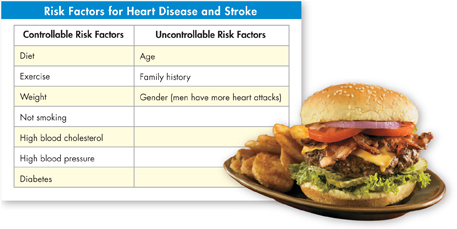High Blood Pressure High blood pressure, or hypertension, is usually defined as a reading of 140/90 or higher. Because hypertension often has no symptoms, people may have it for years and not know. Meanwhile, heart damage occurs as the heart struggles to push blood through vessels. Hypertension also causes small tears in blood vessels, which sets the stage for atherosclerosis. Likewise, the stiffened arteries that result from atherosclerosis can contribute to high blood pressure. Diet, exercise, and prescription drugs can help control hypertension. Uncontrolled hypertension can lead to heart attack, stroke, and kidney damage.

FIGURE 33–12 Risk Factors for Heart Disease and Stroke Some risk factors for heart disease can be controlled because they are related to behavior. For example, people can control their diets and their exercise levels and many can take medication to control diabetes. But other risk factors, such as age and family history, cannot be controlled.
ddddUnderstanding Circulatory Disease
 What is the connection between cholesterol and circulatory disease?
What is the connection between cholesterol and circulatory disease?
Diseases of the circulatory system do not have a single cause. Figure 33–12 lists several factors that increase the risk of heart and stroke. Although many risk factors can be controlled, this can be difficult. In some cases, medications may not be accessible or may not be effective. For example, blood cholesterol levels can be difficult to control. But researchers have learned a lot about blood cholesterol levels, their connection to atherosclerosis, and how the condition can be managed.
What Is Cholesterol? Cholesterol is a lipid that is part of animal cell membranes. It is also used in the synthesis of some hormones, bile, and vitamin D. Cholesterol is transported in the blood primarily by two types of lipoproteins—low-density lipoprotein (LDL) and high-density lipoprotein (HDL). LDL is the cholesterol carrier that is most likely to cause trouble in the circulatory system because it becomes part of plaque. HDL, often called good cholesterol, generally transports excess cholesterol from tissues and arteries to the liver for removal from the body.
Measures of a person's blood cholesterol actually are measures of lipoproteins. Normal total blood cholesterol levels range from 100 to 200 milligrams per deciliter (mg/dL). A person's LDL level should be less than 100 mg/dL. A man's HDL level should be greater than 40 mg/dL; a woman's HDL level should be greater than 50 mg/dL.
MYSTERY CLUE

Both John and Lila have LDL levels well over 200 mg/dL. What disease are John and Lila's doctors trying to prevent?
Table of Contents
- Formulas and Equations
- Applying Formulas and Equations
- Mean, Median, and Mode
- Estimation
- Using Measurements in Calculations
- Effects of Measurement Errors
- Accuracy
- Precision
- Comparing Accuracy and Precision
- Significant Figures
- Calculating With Significant Figures
- Scientific Notation
- Calculating With Scientific Notation
- Dimensional Analysis
- Applying Dimensional Analysis




